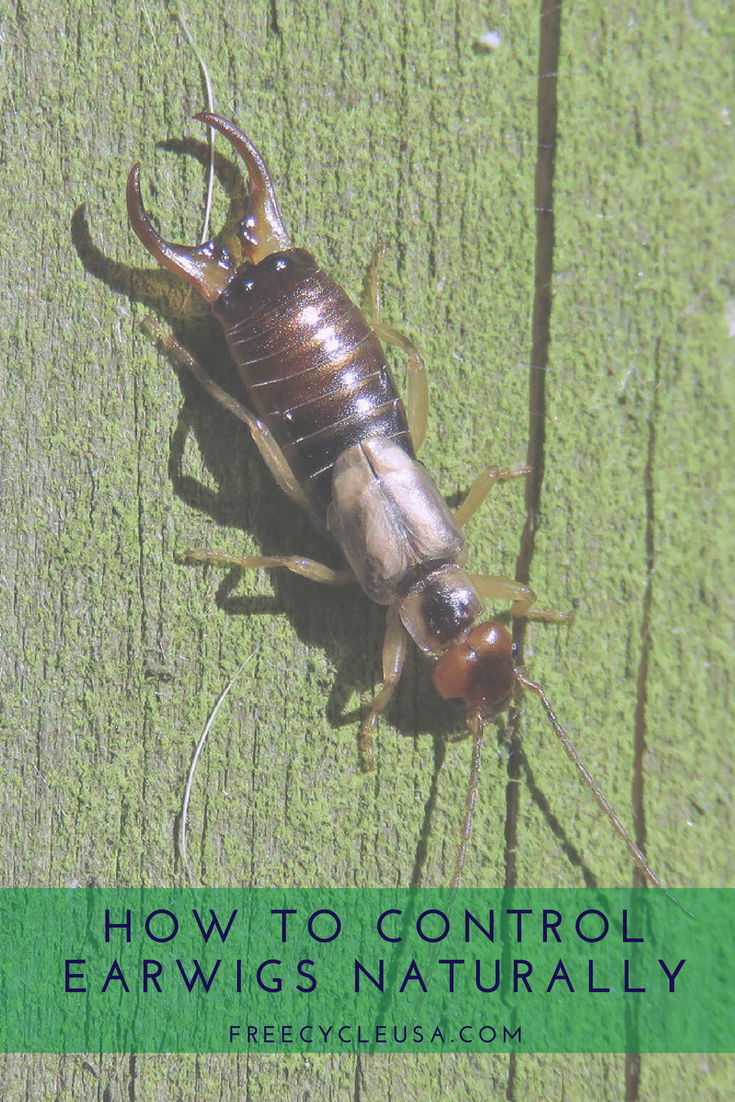They do feed at night and do seek out dark, cool, moist places to hang out during the day. Some common hiding places are under organic matter such as mulch, pine straw, leaf litter, and other debris, loose wood chip mulches, decaying matter, rotten fruit on the ground, wood, boards or tree branches that are on the ground, under dense growth of vines or thick cover and flower pots, any thing moist that will shade and protect them from the sun. As well as hiding in piles of firewood you didn't use last year and let us not forget hanging out inside that small wooded shed you have out back that you haven't been gone inside in years. While Earwigs are scavengers, eating dead insects, decomposing plant materials they can also eat live plants and damage your vegetables and feed on the flowers of plants, including marigolds, petunias, hibiscus, and many other plants. Earwigs leave many small holes in plant leaves and flowers.

Seedlings and most flowering plants can be severely damaged or even killed when you have a large earwig population (coffee grinds will protect). Earwigs can produce large populations rather quickly and can become a major problem for the homeowner over night! They are attracted to lights so they will come in at night attracted to any lights that are on; as well as to any lights that you have on during the day which will cause them to hang out there esp if it is a cool area. Earwigs can be found in most homes and can get in through entry points like doors and windows, going up through the broken walls and any cracked openings, broken screens. They do have a beneficial role in the landscape and have been shown to be important predators of aphids, mites, most insect eggs, and most soft bodied insects such as white flies. They do have a very disagreeable odor when crushed.
Some Natural Controls
Hint: earwigs are attracted to moisture
Control water around the outside of the house. Repair any leaks. Convert to drip system to keep water below ground. Regularly control weeds and clean up dead debris. Eliminate high moisture areas around walls, in mulch, under stones, boards, etc. Control damp moist conditions in crawl spaces, faucets, along the foundations. Change landscaping by creating a dry border immediately around the house walls. Gravel or flat stones can make an attractive barrier against earwigs and other pest invaders. Rain gutters should direct water away from the house. Caulk or use weather stripping at all possible entry points such as doors, windows, pipes, repair screens and doors and windows. Where earwigs are a problem, eliminate hiding places that have high moisture levels. Initiate a regular daily trapping program. Removing earwig habitats is very important to the control of all insects, including earwigs. As they are attracted to lights, stop lighting outside at night. Remove the white light and install yellow LED ones instead.
Inside the Home
Indoors earwigs should be vacuumed up daily; be sure to kill them and dispose of them by dumping into a plastic bag and tying and throw into trash, promptly so they will not re-invade. If earwigs are a regular problem in a building, inspect the area to see how they are getting in the house and seal and chaulk up cracks and all entry points. Repair all broken screens.
Natural Sprays
You can make a natural spray that will keep them from coming into the house. Use 1/2 oz per gallon water of any of the following essential oils available
1. citronella oil
2. cinnamon oil
3. pennyroyal oil
4. clove oil
5. lavender oil
6. citrus
7. basil
8. any natural essential oil can be use the above are just a few. Try your own.
Citrus Spray Use OTKO a Natural Citrus Cleaner. Spray straight through a mister. Will kill earwigs and most of insects on contact. Soap Spray Use any natural castile soap like Dr Bronners soaps. They make peppermint, lavender, almond, tea tree and lot of other natural sources. Use 1oz per gallon water. Will kill earwigs when sprayed.
DE SPRAY Gadren Grade DE can be added to water and sprayed. Best way is to put some DE into a panty hose and suspend in gallon water. Allow to sit, pour into a gallon sprayer and spray. when dried the de will act as a barrier and kill and earwigs that crawl over it. You can use just dust the areas with it.
Check List
Vacuum, vacuum ad vacuum…
Vacuum up any earwigs inside your house. Vacuum very thoroughly and as often as needed. Throw away the bags in the trash.
Natural Dust
Garden Grade DE can be used as a dust around the house as well as under the house and the attic. Dust lighly and allow to sit.
Boric Acid can be used as a dust in cracks and other areas between the house walls.
Reducing Populations:
Traps inside the house is one ongoing way of you managing earwigs in the home on a regular long term bases.
Various Traps
Ultimate Flea Trap is by far the best insect trap on the market. This one uses no chemicals and only a small light with a sticky mat that get the insects trapped that are attracted by the light. Place one in every room that has earwigs. It also works on fleas ( thus the name) as well as on spiders, cockroaches and most other insects.
Outside the house
Remove materials outside the perimeter of the building that could provide as a hiding place, such as ivy, plant debris, leaves in gutters, old wood piles, old leaf litter, piles of newspapers, or other organic material. Caulk and repair cracks, crevices, and other openings around the foundation or around the outside of the house. Manage moisture around the building by repairing or replacing leaky faucets, leaky air conditioners, leaky drains, control water going into the foundation after it rains, and provide crawl spaces to allow for entrance. Repair or change the conditions to promote a drier environment. Caulk and weatherstrip around doors. windows. bathrooms water outlets as well electrical outlets.
Go through any areas inside that is dark and they can hide in. Cardboard boxes will make a great host place for them to hang out inside the house. Remove any other debris such as old unused firewood. Always keep moisture away from your home by repairing any defective rain spouts, keeping the grading in an area so water drains away from the home, and by keeping proper ventilation in crawl spaces to allow area to dry out.
Earwigs are attracted to outdoor lights, so replace them with Yellow LED lights, which are less attractive to earwigs. Treatment should be done outside with natural applications of garden grade DE around the building foundation, flower beds, mulch areas and turf within a couple of yards of the building, as well as in the crawl space areas of the home. Treat in a two foot band around the building adjacent to the foundation to limit earwigs from getting inside. Establish dry border right around the base of the houses for great control.
Traps outside the house
Newspaper: A rolled-up wet newspaper held together with a rubber band.
Cardboard Box: Punch pencil-size holes along bottom edge of cardboard box.
Old Garden Hose: 12-24 inch pieces of garden hose
Used cat food can. Add 1/2 inch any type beer or wine.
Tupperware: Use a tupperware like plastic container. Punch holes along the top edge of the tub, add 2 inches any cheap wine and cover with top and sink into ground.
Finch Bird House can be used as a housing unit where you can place a 8 oz plastic cup 1/2 filled with beer or wine. I would try one of each and see which attracts the most.
Trapping is an effective, easy approach to reducing earwig populations.
One of the key element of a natural earwig management program is a daily active trapping system. Just before dark, place the bird finch traps throughout the yard in out of sight places. In the morning, shake them out the traps over a pail of Dr Bronners Soap / water or any natural soap n water. Keep trapping until you do not catch any more earwigs. Traps can be hidden near shrubbery and ground cover plantings, or against the house. For fruit trees, keep weeds, brush, and the suckers (always prune) away from the base of trees throughout the year because they provide refuge for earwigs, snails and other creatures. Monitor populations by counting amounts of earwigs caught in the traps.
Eliminate Their Habitat:
Altering the habitat around your garden will reduce earwig population and damage. Get rid of their hiding places: boards, weeds, wood piles, plant debris, leaf litter, and any other objects that create dark, moist hiding places. Do not plant dense ground covers, such as ivy, mint, herbs,, next to vegetable or flower gardens. Raise vulnerable seedlings indoors until they are able to withstand some munching. Or start them outdoors on a table with legs protected by sticky barriers.
Some folks advise against the use of organic mulch because they say it provides harborage to pests such as earwigs and spiders. I have the opposing view that organic mulch offers earwigs a diverse hunting area that will save your plants as well as provide for the earth's needs. Mulch can easily be kept clean of earwigs by dusting with garden grade several times per year or by dust just before and after every time you apply a new layer of mulch. Spraying the mulch with any natural soap will also control them too.
Andy Lopez
The Invisible Gardener
[ad_2]




